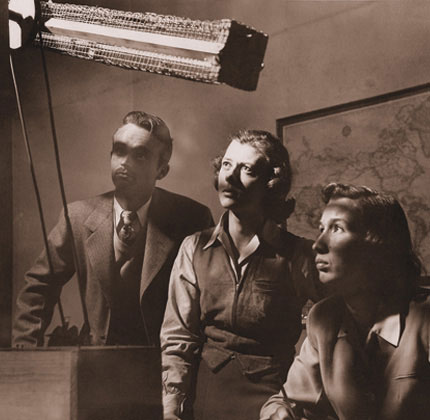nonfiction
Believe It or Not
Author Stacy Horn explores a laboratory’s investigations into the paranormal
by Renée Alfuso / CAS ’06
On January 15, 1949, a 13-year-old Maryland boy began demonstrating disturbing behavior—he would projectile vomit and speak in foreign languages, his bed shook violently, and words appeared scratched into his body. If the events sound familiar it’s because they would later become the basis for the classic horror film The Exorcist (1973) and, sure enough, the boy’s deeply religious mother was convinced that he was possessed by a demon. But a priest who witnessed the episodes firsthand believed a poltergeist was more likely to blame, and so he turned to a higher authority: the Parapsychology Laboratory at Duke University.
When J.B. Rhine, who headed the lab, learned of the strange case, he supposed yet another theory: The boy himself was behind the phenomena, whether through simple trickery or perhaps psychokinesis (the ability to move objects via brainpower). Rhine, considered “the Einstein of the paranormal,” believed more in the abilities of the human mind than he did in ghosts. He struggled his whole life to bring psychical research away from the fringe and into the realm of science, and is the central character of Unbelievable: Investigations Into Ghosts, Poltergeists, Telepathy, and Other Unseen Phenomena From the Duke Parapsychology Laboratory (Ecco), a new book by Stacy Horn (TSOA ’89). Using exhaustive research and countless interviews, Horn chronicles the lab’s work, from 1930 to 1980, and vividly describes the scientists’ juiciest encounters, from the bizarre (a telepathic horse named Lady Wonder) to the heartbreaking (a fame-hungry psychic who strung along the parents of a missing boy).
A frequent contributor to NPR’s All Things Considered, Horn was drawn to the once-prominent lab by her fascination with forgotten stories, which gives her writing the tone of investigative journalism despite a background in telecommunications. Where many would dread the labor of sorting through dusty piles of documents, Horn sees opportunity. Her previous book, The Restless Sleep: Inside New York City’s Cold Case Squad (Viking), required digging through warehouses of evidence, and she recalls feeling like “a kid in a morbid candy shop.” So the chance to rummage through the Duke lab’s 700 boxes of archives—which took almost three years—was especially appealing. “If there’s a basement that nobody’s gone into for decades, I want to go through that door and look at what nobody has for 100 years,” she says.
Horn’s interest in Rhine’s work put her in good company: Helen Keller, Aldous Huxley, Richard Nixon, Jackie Gleason, and Carl Jung were among the many who wrote and visited the lab. In the 1930s and ’40s, particularly following WWII, people desperately wanted proof of life after death and sought out mediums to reach their dearly departed. The burning question for Rhine was whether such seers were actually communicating with the dead or simply getting their answers through extrasensory perception (ESP). He decided the first step was to focus on telepathy—the ability of the mind to communicate with another. Eventually Rhine and his colleagues were testing up to 100 people for ESP each week using simple card experiments. By 1940, the lab had conducted nearly a million trials, which provided statistical evidence that the mind could exhibit telepathic powers. “Instead of bowing before the unexplainable, we begin to experiment with it,” Rhine observed.
But the public, and even the lab’s financers, weren’t interested in science. Hundreds of letters poured in each day from people hungry for answers to inexplicable experiences—and they wanted someone to investigate them. Rhine was reluctant to start chasing after things that go bump in the night, but a 13-year survey of the letters, which eventually totaled more than 30,000, found that 3 percent of the stories could not be explained by his telepathy theories. These “spontaneous psychic experiences,” as the lab carefully dubbed them, showed possible evidence of “incorporeal personal agency”—their scientific term for ghosts. The only way to study them was to venture into the field.
Horn went to Duke expecting to uncover the real-life Ghostbusters. But, unlike in the movie, the lab’s task was not as simple as showing up with a proton pack and ghost trap. In most cases, the reported disturbances would cease before the scientists arrived. Perhaps the most elusive was the poltergeist—which means “noisy ghost” and is often exhibited by flying objects and slamming doors—because they seldom last long. But the activity can be prolific, as one Long Island family discovered in 1958, when they were startled by loud popping noises and found a crucifix fallen from the wall, broken toys strewn about, and bottles, including one containing holy water, unscrewed and emptied. Five weeks and some 67 events later, it stopped as abruptly as it began.
Over the years, the lab debunked thousands of reported ghosts and psychics, but some incidents remained beyond explanation. As decades passed, the lab’s friends and contributors died without knowing for certain whether an afterlife awaited them. Eventually the university grew less interested in parapsychology and the lab separated from Duke in 1962. When Rhine died in 1980, at 84, his work had never been fully accepted by the disbelieving scientific community, despite years of adherence to modern experimental procedure. Like Rhine, Horn is skeptical about ghosts but believes that there are happenings we can’t fully explain—yet. “I don’t know that it’s something from the afterlife, but it could be something even more interesting,” she says. “And to me that’s just as thrilling as a paranormal explanation.”
Photo Courtesy the Rhine Research Center Archives







